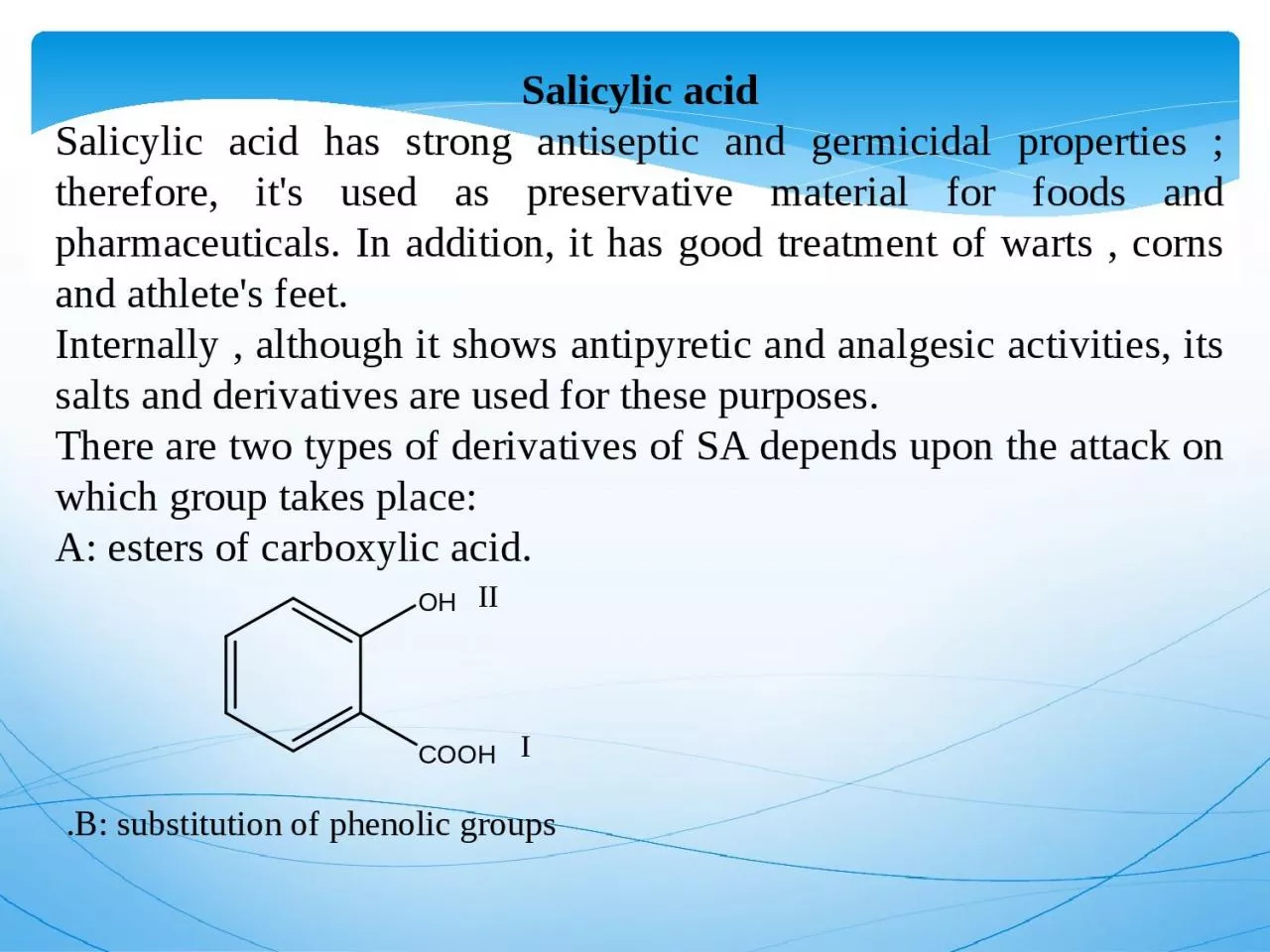

Internally although it shows antipyretic and analgesic activities its salts and derivatives are used for these purposes There are two types of derivatives of SA depends upon the attack on which group takes place ID: 1030409
Download Presentation The PPT/PDF document "Salicylic acid Salicylic acid has strong..." is the property of its rightful owner. Permission is granted to download and print the materials on this web site for personal, non-commercial use only, and to display it on your personal computer provided you do not modify the materials and that you retain all copyright notices contained in the materials. By downloading content from our website, you accept the terms of this agreement.
1. Salicylic acidSalicylic acid has strong antiseptic and germicidal properties ; therefore, it's used as preservative material for foods and pharmaceuticals. In addition, it has good treatment of warts , corns and athlete's feet.Internally , although it shows antipyretic and analgesic activities, its salts and derivatives are used for these purposes.There are two types of derivatives of SA depends upon the attack on which group takes place:A: esters of carboxylic acid. B: substitution of phenolic groups.
2. Most of these derivatives are introduced to minimize the gastric disturbances, hemorrhage irritation and undesirable taste.The advantage of these derivatives is to increase the effects and decrease side effects.Examples:Ammonium salicylate.(H.W)Sod. Salicylate .(H.W)Methyl salicylate.(H.W)Ethyl salicylate .Strontium salicylate (sod. Salicylate+bismuth nitrate) .(H.W)Salicylamide.(H.W)Salysal (ester linkage between two molecules of SA sal-ester-sal)
3. 8.Salol. 9.Acetyl salicylic acid.(H.W)
4. Salicylic acid and acetyl salicylic acid: Salicylic acid was a good analgesic and antipyretic, but it has an unwanted teste and an irritating effect on the stomach, people could not tolerate taking SA. SA was treated with acetic anhydride in the presence of H2SO4 to give acetyl salicylic acid (ASA), this compound is known as aspirin tested as better and much less acidic than SA; so that the patient could tolerate taking aspirin by mouth.
5. Aspirin possesses a NO. of properties that make it the most often recommended drugIt is analgesic, effective in relieving headache pain.It is anti-inflammatory agent providing some relief form the swelling associated with arthritis and minor injuries.It is antipyretic agent, it reduces fever Recently it is used as prophylaxis of heart attack
6. Differences between SA and ASA:1. SA gives +ve result with ferric chloride FeCl3 because it contains free OH gp., while ASA give –ve result because (OH) gp. Of SA is acetylated to give ASA.
7. 2. SA can not be used internally because it causes stomach irritation while ASA is less irritating.3. Melting point of SA differs from that of ASA.4. Salicylate anion is stabilized by intramolecular H bonding; therefore, SA is more slightly soluble in water than ASA (SA<ASA).
8. Preparation of salicylic acid:Industrial method:1. Kolbe's reaction:
9. The OH gp. Strongly activates the aromatic ring towards electrophilic attack . electron delocalization of phenoxide anion leads to increase electron density at the position of ortho and para to oxygen ( resonance structures).The increased nucleophilicity of the ring permits it to reacts with carbon dioxide, an intermediate is formed which is keto form of salicylate anion.
10. 2. Reimer-tiemann reaction:
11. Lab. Method ( alkaline hydrolysis of ester ): SA is prepared from methyl salicylate by hydrolysis of ester group with aqueous alkali (NaOH or KOH)
12. The mechanism :1. Nucleophilic addition of OH- ion to the carbonyl gp:2. Proton transfer to anionic form of tetrahedral intermediate:
13. 3. Dissociation of tetrahedral intermediate:
14. 4. Proton transfer yields an alcohol and carboxylate anion:
15. Procedure:Place 5g of oil of methyl salicylate (0.1 g of wintergreen ) in a 250 –ml distilling flask together with 50 ml of 20% (w/v) aq. sol. Of NaOH.Mix well, the sod. Salt of methyl salicylate phenolic gp may separate out at this point, but will redissolve on heating.Reflux at the boiling point for 15-20 min.Transfer the mixture to a 125-ml beaker, cool and acidify with dil. H2SO4 (check acidification by litmus paper).Filter the precipitated SA with suction and dry.Recrystallize from the minimum amount of hot water and weigh the pure SA (white crystals). (MP=165-167 )(M Wt = 138 g/mol).